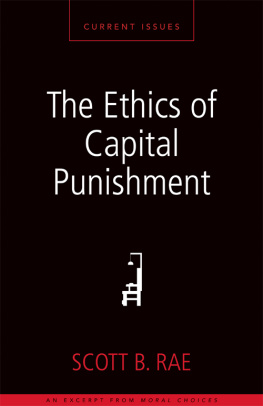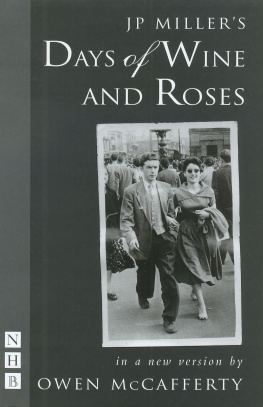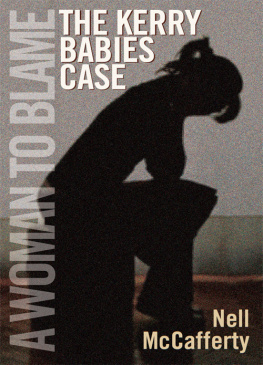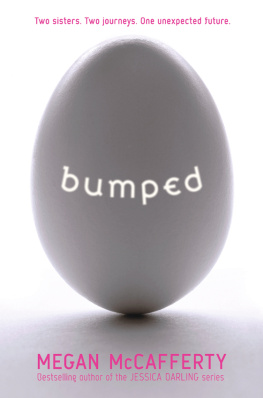CAPITAL PUNISHMENT
CAPITAL PUNISHMENT
James A. McCafferty, editor
For Jane
First published 1972 by Transaction Publishers
Published 2017 by Routledge
2 Park Square, Milton Park, Abingdon, Oxon OX14 4RN
711 Third Avenue, New York, NY 10017, USA
Routledge is an imprint of the Taylor & Francis Group, an informa business
Copyright 1972 by Taylor & Francis.
All rights reserved. No part of this book may be reprinted or reproduced or utilised in any form or by any electronic, mechanical, or other means, now known or hereafter invented, including photocopying and recording, or in any information storage or retrieval system, without permission in writing from the publishers.
Notice:
Product or corporate names may be trademarks or registered trademarks, and are used only for identification and explanation without intent to infringe.
Library of Congress Catalog Number: 2009036900
Library of Congress Cataloging-in-Publication Data
Capital punishment / James A. McCafferty, editor.
p. cm.
Originally published: Chicago : Aldine-Atherton, [1972]
Includes bibliographical references and index.
ISBN 978-0-202-36328-8
1. Capital punishment--United States. I. McCafferty, James A.
HV8699.U5M3 2009
364.660973--dc22
2009036900
ISBN 13: 978-0-202-36328-8 (pbk)
Contents
JAMES A. McCAFFERTY
HUGO A. BEDAU
WALTER C. RECKLESS
WILLIAM O. HOCHKAMMER, JR.
JACQUES BARZUN
ERNEST VAN DEN HAAG
EDWARD J. ALLEN
RICHARD E. GERSTEIN
JAMES V. BENNETT
RICHARD A. MCGEE
RAMSEY CLARK
PRESIDENTS COMMISSION ON LAW ENFORCEMENT AND ADMINISTRATION OF JUSTICE
JUDICATURE
SARA R. EHRMANN
VICTOR H. EVJEN
JACK GREENBERG AND JACK HIMMELSTEIN
SOL RUBIN
The most challenging contributions to the capital punishment controversy of the twentieth century were made during the 1960s. The 1970s promise a resolution of what has been an endless and arduous debate.
Most of the research and independent studies on the subject of capital punishment were produced during the last decade. Therefore, it was a demanding task to select articles that represent an evenhanded discussion of the controversy and include a meaningful dialogue between the proponents and opponents of the death penalty. The major effort was to provide readers with recent writings that tend to illustrate selected points. The material herein represents only a fraction of the recent literature on capital punishment.
Capital punishment has been debated since the founding of this country both in small groups and in the halls of the state legislatures and the Congress of the United States. Emotions often run counter to reasonable discussion. Capital punishment advocates conjure up crime victims who have met horrible deaths by shooting, poisoning, strangling, butchery and other horrors. Capital punishment opponents describe the whine of the electric generator as it surges a charge of electricity through the condemneds body, his gasp for air in the gaseous asphyxiation chamber, or the snap of the rope and the death rattle of the body at the end of the hangmans noose. Instead of attending to such material, this book is dedicated to a nonemotional, rational study of capital punishment.
This book is prepared for those students of human behavior who seek relevant information about what is happening in a crucial area of the criminal justice system. Sir Winston Churchill noted that the mood and temper of the people with regard to the treatment of crime and criminals is one of the unfailing tests of the civilization of any country. Those who speak of rehabilitation of offenders on the one hand and, on the other hand, signify their acceptance of capital punishment are faced with a difficult mind bending situation. Herein lies a possible credibility gap between our effort to maintain life and the complete destruction of the lives of condemned persons. It is the responsibility of todays students, who will be future leaders, to determine what protections are needed from the wanton killer who seemingly cannot be deterred except by the ultimate penalty.
Unlike many social issues there is no real middle ground in the capital punishment controversy. Both sides of the controversy will be told here. It will be the responsibility of the reader to determine which set of arguments best supports his position. Whether the choice is to oppose or to defend the death, penalty, the decision will be reinforced or eroded by day-to-day events.
A word on style: instead of a complete presentation in the Introduction, I have used the beginning of each chapter to develop the overall exposition. Collectively, the introductory statements should provide a thorough picture of the capital punishment controversy.
I am indebted to my friends who permitted me to republish their contributions. Because of space limitations, fully one-half of the material for which permission for publication was obtained had to be set aside. Special acknowledgements go to Dr. Gilbert Geis, who suggested this controversy, to Dr. Walter C. Reckless, who advised me on my thesis on capital punishment at The Ohio State University and to Victor Evjen, who as editor of Federal Probation asked me to write on this subject some years ago. Thanks to my wife and children, Cindy, Stanley and Bridget for permitting me to put aside household chores so that I could devote time to preparation of this material. Nancy Hunt and Mrs. Sally Howley assisted in the preparation of the manuscript and David Martin helped with the bibliography.
Finally, my thanks to you the reader as you study this subject. Look to this volume and to the many other writings on capital punishment with special reference to the selected bibliography. The use or disuse of capital punishment indicates societys response to questions going directly to the issues bearing on the preservation of civilization.
JAMES A. McCAFFERTY
During the 1960s sentences of death and the actual imposition of such sentences grew increasingly further apart. During the early part of the decade, an average of 100 persons were sentenced to death each year. About 15 of these were ultimately executed. In the final four years of the sixties, the number of persons sentenced to death remained the same, but only three persons were executed.
To some extent, the decrease in executions has been the result of automatic appeals and executive reprieves, both of which result in further delay. Outright commutation to life imprisonment, such as was announced in 1971 by Governor Winthrop Rockefeller for 15 men in Arkansass death row, brought to a finality the moratorium on executions in that state. Signaling his long opposition to the death penalty, the Governor was the first state executive to commute all death sentences. He announced that the individual records of the nine men convicted of murder and the six sentenced for rape were not relevant to his decision.
Why has capital punishment become a national concern? The reason appears to be that for the first time in American jurisprudence, appeals have been taken into both State and Federal courts on behalf of capital offenders. This effort has been organized by groups of citizens who are unalterably opposed to the death sentence. Pending the disposition of such appeals, the use of capital punishment has been held in abeyance.









